What’s round, pear-shaped, or oblong, and often a rich purple color? If you live in the United States, English-speaking Canada, Australia, or New Zealand, you know it as eggplant (Solanum melongena).
Or maybe “guinea squash,” if you live in the southern states.
In other English-speaking parts of the world, including Ireland and the UK, you probably call it aubergine instead. This is also true in Quebec and much of Europe.
This pretty word is also used to describe the deep purple color of an eggplant, and I personally love using it in writing whenever the opportunity arises.
In English-speaking portions of South Africa, Malaysia, and South Asia, this member of the nightshade family, Solanaceae, is often known as “brinjal.”
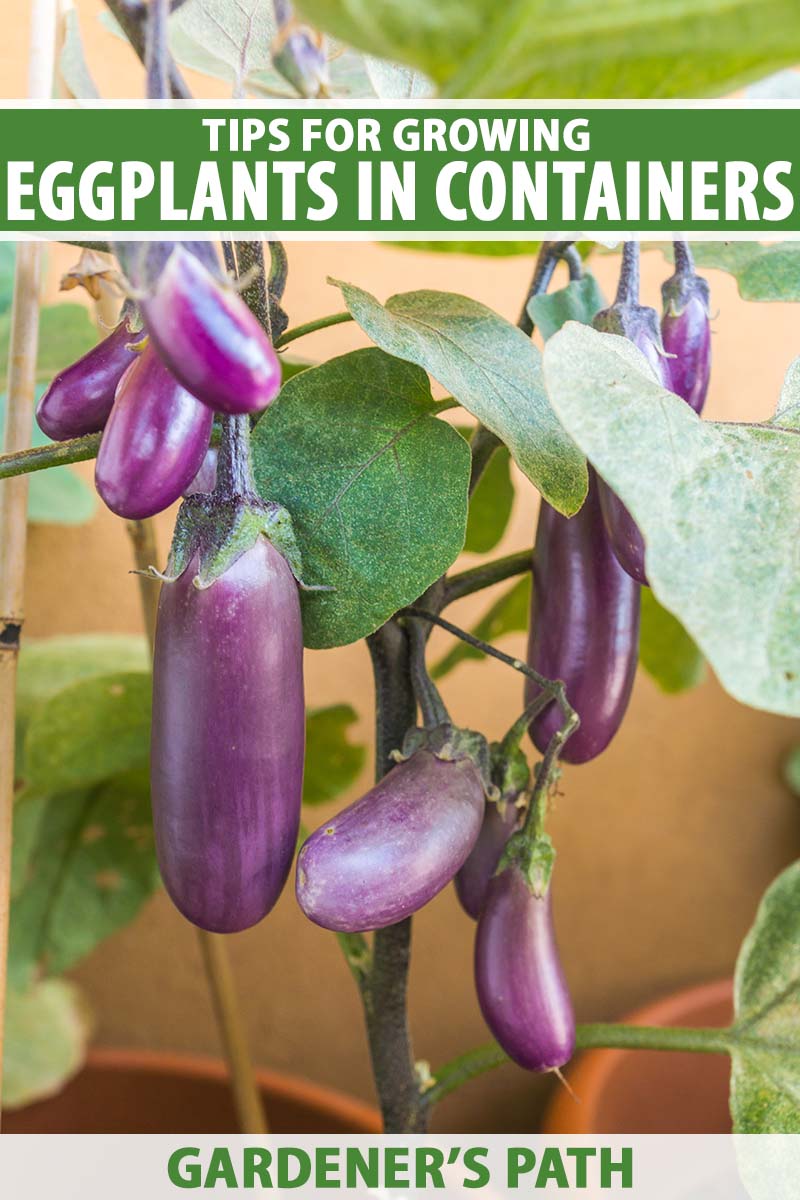
We link to vendors to help you find relevant products. If you buy from one of our links, we may earn a commission.
Whatever you happen to call it, this delightful berry (we’ll get into this startling fact in a moment!) grows well in a container.
So if you don’t have space in your garden, or you live in an urban area and want to add aubergine to your patio container garden, S. melongena is an ideal choice.
Ready to grow? Let’s get started!
Here’s what we’ll cover:
What You’ll Learn
An Eggplant Primer
Eggplants typically grow 18 to 36 inches tall with a spread of 24 to 36 inches. Each plant generally bears between two and 12 fruits, although this number varies based on the variety and growing conditions.

If you’ve ever enjoyed a plate of crispy, savory eggplant parmesan with marinara sauce, you might be surprised to learn that you’re eating two kinds of berries: the eggplant, and the tomatoes.
This is because, botanically speaking, a true berry is a fruit that develops from one flower that has one ovary.
Our aubergine friend fits into this category. Yet, despite its classification as a berry and its center filled with seeds, nutritionists and chefs alike consider it a vegetable.
And while Americans might be most familiar with the elongated, pear-shaped, dark-purple version of the vegetable, its long history of cultivation has resulted in fruits of several different sizes, shapes, and shades of white, green, pink, purple, and even orange.
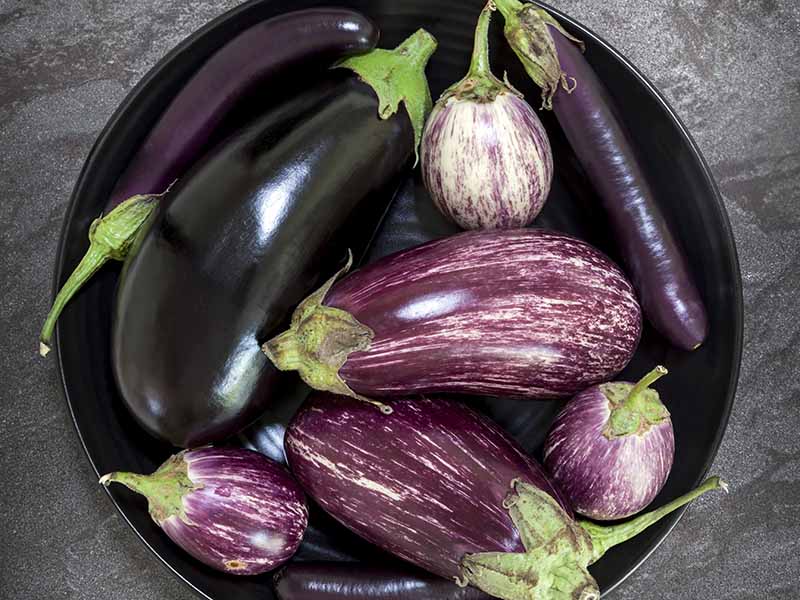
It’s popular in cuisines worldwide. In Malaysia, sambal eggplant is a spicy, delicious dish best served over rice.
And one of my favorite dishes to eat at any Indian restaurant is baingan bharta, a curry made with minced or mashed eggplant. This dish and its many variations are popular in India, Bangladesh, and Pakistan.
In Lebanon, Greece, and Turkey, cooks make a succulent dish of eggplant stuffed with various ingredients – rice, lamb or beef, pine nuts, onions, and more. Delicious!
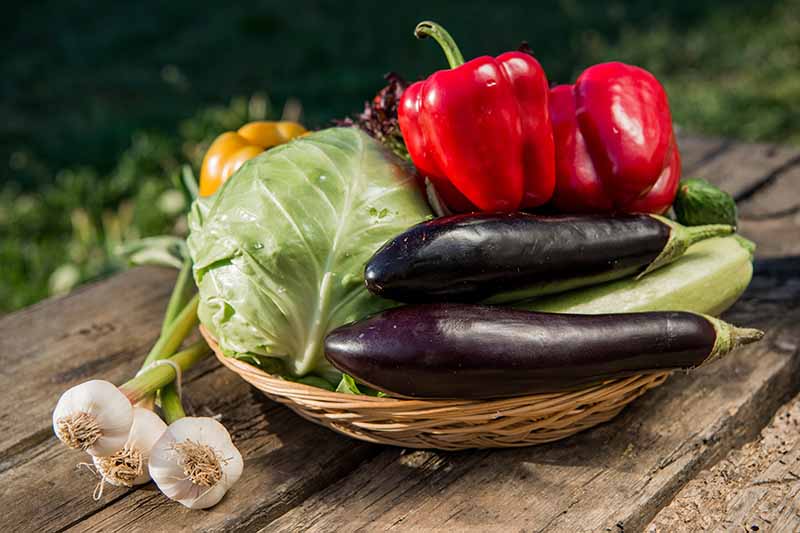
And it is nutritious, too: the fruits are rich in potassium and folate, along with other key vitamins and minerals.
If you live in USDA Hardiness Zones 5 through 12, you can grow it outdoors in containers.
S. melongena is a perennial plant in warm climates, so those of you in Zones 10 to 12 can enjoy harvests year after year from the same plant.
The rest of us have to grow it as an annual outdoors, because this member of the nightshade family – which includes potatoes, tomatoes, and peppers – does not like the cold.
In addition, this plant thrives in rich, loamy soil with a pH between 5.5 and 7.2.
Why Grow in a Container?
Saving space is the main reason to grow eggplants or other veggies in containers. It’s the perfect option for those who don’t have big yards or gardens – and even for those whose gardens are already overflowing with all sorts of other delights and just don’t have room for a new addition in the ground.
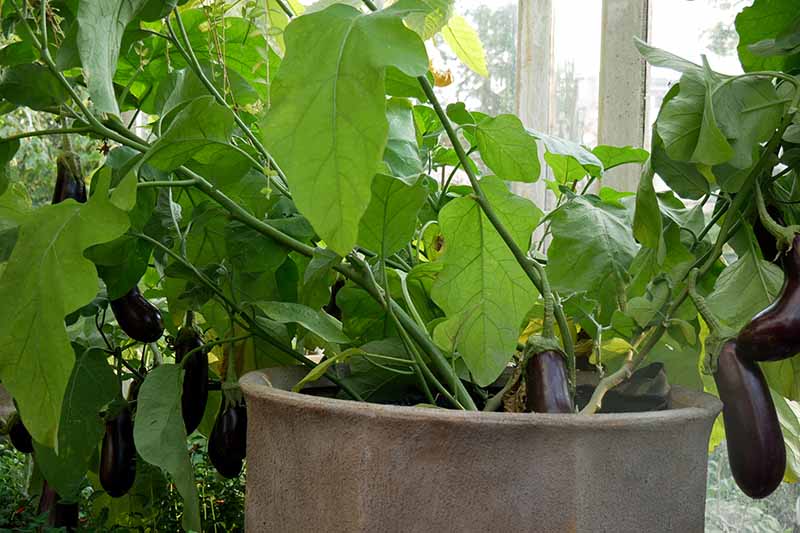
Eggplant is also one of those vegetables that adapts well to container growth, producing plenty of delicious fruit despite its more confined surroundings.
Since S. melongena is perennial if given the right conditions, you can even bring the plant indoors over the winter to keep it alive until the weather warms up again in the spring.
So find a nice, sunny spot on your patio and get ready to grow some eggplant!
Choosing the Right Container
You’ll need a pot that’s 12 to 14 inches deep and wide if you’re growing a compact variety, or a 20-inch-deep pot if you’re not.
You can grow one compact plant in a 12- to 14-inch pot, or one regular-sized plant in a 20-inch pot. If you’d like an extra-large yield, you can also choose to grow two compact cultivars in one 20-inch pot.
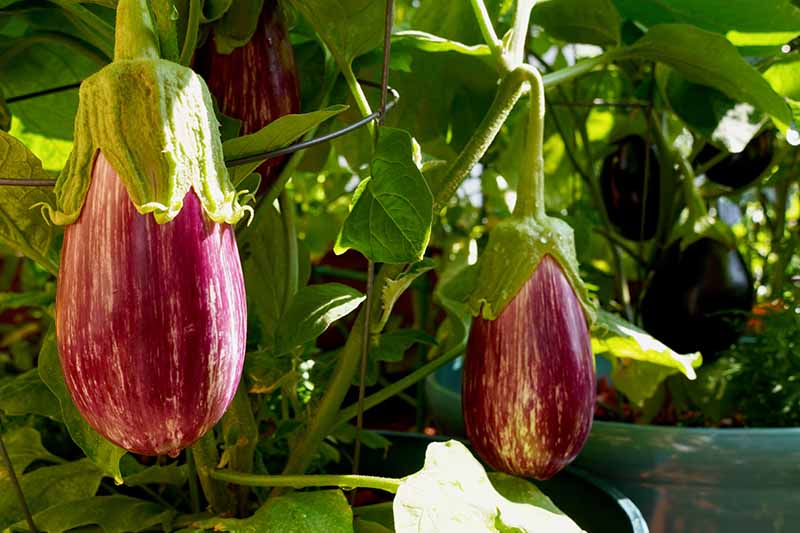
Make sure the container you choose has drainage holes so the soil doesn’t get soggy, which could potentially cause root diseases to develop.
Since the plant is bound to get a little heavy, what with all those delicious fruits hanging off it, you’ll want to invest in a sturdy container that won’t tip over easily.
Terra cotta works well, or a wooden whiskey barrel planter with enough cracks to allow for adequate drainage. Even a sturdy, heavy plastic planter can work.
To explore additional options, check out our guide to choosing the right pot for your container garden.
Also, keep in mind that if you choose to plant a regular-sized cultivar that grows up to three feet tall (or possibly taller, if it’s allowed to grow as a perennial), you’ll need a tomato cage to support the plant and its fruit.
Preparing Your Container
Fill your chosen container with fresh potting mix, and add some vegetable-specific fertilizer according to package instructions.
I like this all-natural 4-4-4 (NPK) vegetable garden fertilizer from Down to Earth, available from Arbico Organics.
Down to Earth Vegetable Garden Fertilizer
Alternatively, you can use a potting mix with added fertilizer, such as Nature’s Care Organic, available from the Home Depot.
Nature’s Care Organic Potting Mix
If you really have to use garden soil, you can do so as long as you mix it 50-50 with well-rotted manure or compost.
Avoid using soil that was already used to grow another member of the nightshade family, as it could carry diseases or pests that may infect your eggplant.
Since S. melongena likes soil with a pH between 5.5 and 7.2, you may want to conduct a soil test before you get started, especially if you’re using garden soil that may be alkaline or overly acidic.
Propagation
To get started on your path to delectable eggplant-based dishes, you can either start seedlings indoors, direct sow them in your containers, or simply purchase transplants from a nursery.
Sowing Seeds Indoors
Sow seeds indoors eight weeks before your area’s average last frost date. I like to use seed trays with humidity domes on top to help lock in moisture.
You could also sow them right in the container you’re going to be growing them in.
These seedling trays from MIXC, available from Amazon, come with adjustable humidity domes. I’ve reused mine several times! (After a deep clean and a soak in bleach-infused water to kill off any potential diseases, of course.)

Fill each seed cell or container with seed-starting mix and place two seeds inside, a quarter of an inch deep. Cover with potting mix, spray with water, and place a humidity dome or some plastic wrap on top of the seed tray.
Keep the seeds moist and warm, and they should germinate in 10 to 21 days. Once germination occurs, keep a grow light trained one inch away from the plants, adjusting it as they grow, for 12 to 14 hours during the day.
When the seedlings have at least one set of true leaves, thin them by pinching the smaller one in each cell off at the base so the bigger one can grow and thrive, leaving no more than one seedling growing per cell.
After your indoor starts (or nursery transplants) are at least four inches tall and all danger of frost has passed in your area, you can transplant them into your containers outdoors.
Just make a hole in the potting mix in your container the size of the seed cell transplant, gently loosen the baby plant from its cell, and set it in its new home. Plant it at the same depth as it was growing in the previous pot.
Backfill with soil and water thoroughly.
Direct-Sow Seeds in Containers
If you live in a warm area where temperatures routinely stay above 65°F at night in the spring, you can direct-sow seeds into your container outdoors.
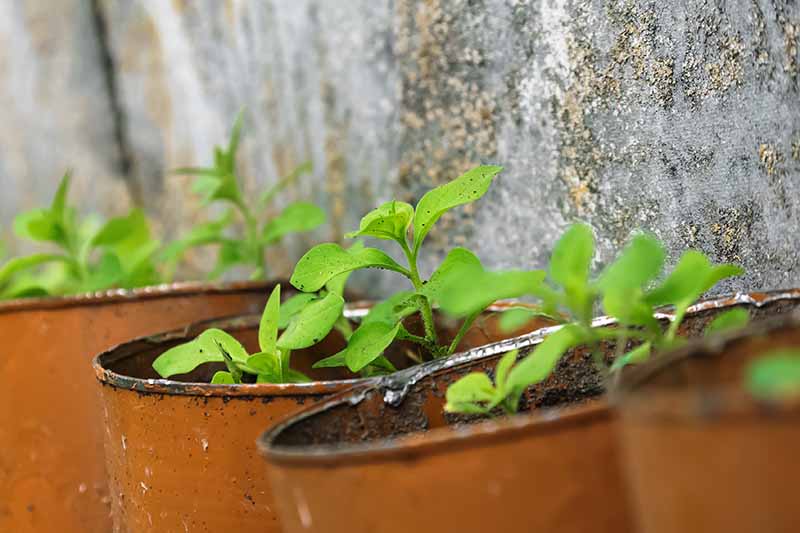
Plant two seeds a quarter of an inch deep in each container. Make sure the pots are in an area that receives full sun, and keep the soil moist until germination occurs.
If you are planting compact varieties in a 20-inch container, space each set of two seeds four inches apart.
Seedlings should emerge within three weeks. Once they have one or two sets of true leaves, thin them to just one seedling per container.
Or, if you’re growing two plants in one larger container, thin so that there are just two plants (instead of four).
How to Grow
Give each plant a slow, deep watering at least once a week.
If you notice that the leaves begin to wilt before the next week begins, give them another watering, keeping the soil lightly moist. Keep in mind that containers dry out a lot faster than the ground does!
You want the soil to feel like a well wrung out sponge, not oversaturated, and not dried out either.
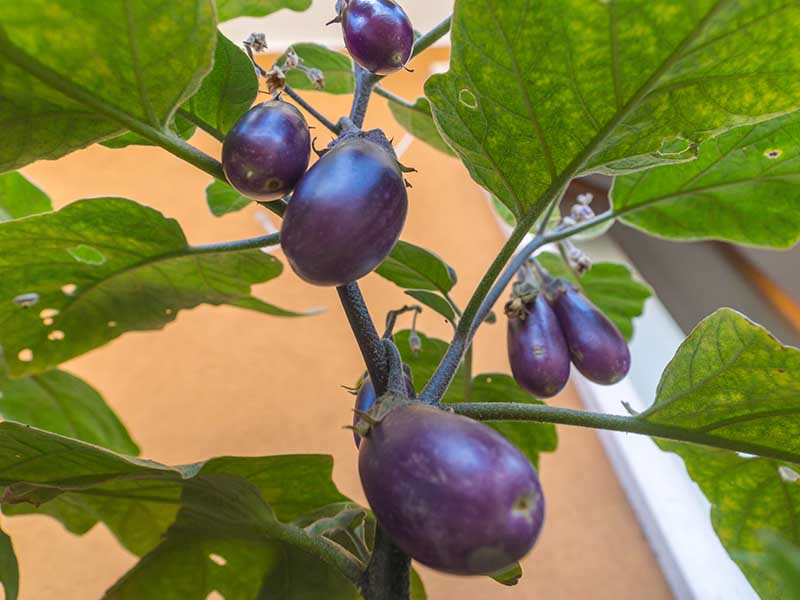
Add a one- to two-inch layer of organic mulch, such as straw, bark chips, or leaf mold, over the top of the soil to help lock moisture in.
Every couple of days, press your finger about two inches down into the soil. If you feel nothing but dryness, it’s time to water.
Make sure to avoid overhead irrigation. Soggy leaves are more prone to developing fungal issues.
If you’re using a tomato cage to help support the fruits, place the cage in your container when the plant has one or two sets of true leaves.
Putting it in the container at planting or transplanting time helps you avoid jabbing the cage down into a well-developed root system, potentially disrupting the plant’s growth and health.
Up until you see the first blossoms, fertilize your plants with a balanced fertilizer according to package instructions.
After the plant begins to flower, you’ll want to ramp up the potassium and phosphorus levels, so aim for a weekly dose of a 5-10-10 (NPK) fertilizer.
Eggplants are self-fertile, and the flowers are pollinated by wind or certain types of bees through a process called buzz pollination, moving the pollen from the anthers to the stigma.
But if you want to help the pollination process along, you can learn more about how to hand pollinate eggplants in our guide.
If you’re lucky enough to live in a growing zone that allows eggplants to flourish as perennials, your plants will keep flowering and fruiting all fall and winter long, provided nighttime temperatures don’t drop below 65°F.
Your plant will stay alive if the temperature falls below 65°F as long as it stays above freezing, but it will stop producing flowers and fruit. And if temps drop to 32°F or below, it won’t survive.
Keep an eye on the weather forecast in your area to make sure the temperature stays favorable.
If a short-lived freeze is coming, you may be able to save your plant by adding an extra three-inch layer of mulch and draping a row cover over the plant.
Use your tomato cage to support the row cover, or add stakes driven three to five inches into the container if you haven’t used a tomato cage for support. Guide them into the soil slowly and try not to disturb the roots.
Or, you could just bring the pots into a garage or other protected area for the duration of the cold spell.
As far as keeping the plants warm enough goes, it takes a bit more work if you decide to tackle the challenge of bringing your container indoors for the winter. We cover this separately, in our guide to indoor growing. (coming soon!)
Growing Tips
- Give each plant a deep soak of water once or twice a week, depending on soil moisture and precipitation.
- Add a layer of mulch to help retain moisture in the pot.
- If using a tomato cage, place it when you plant the seeds or at transplant time, before roots develop enough to be significantly disturbed.
- Fertilize with a balanced, vegetable-specific fertilizer up until the first blooms appear, and then switch to a tomato fertilizer with higher ratios of potassium and phosphorus.
Cultivars to Select
Let’s take a look at a few of the best compact eggplant cultivars to grow in a container. These won’t need supports if you don’t want to use them, although you can add a tomato cage if you like.
Fairy Tale
If you want tiny, delicate fruit with a striking purple-and-white coloring, try ‘Fairy Tale,’ one of the best hybrids out there for container growing.
Maturing in only 50 days, this plant grows just 16 to 18 inches tall and spreads 12 inches, making it one of the most compact aubergines around.
Each pretty fruit is just four to five inches long at maturity, although you’re encouraged to pick at two to three inches for peak sweetness and flavor.
You can find seeds in a variety of packet sizes available from True Leaf Market.
Finger Fruit Purple
For dark purple miniature eggplants that look ready to snack on off the bush, try ‘Finger Fruit Purple.’ But really, don’t forget to cook them first.
This variety produces elongated fruits about four or five inches in length and one to two inches wide.
Pick them when they’re the size of a finger for a sweet, mild, succulent flavor. Roast them whole and serve with your favorite stir-fry or spaghetti dish!
‘Finger Fruit Purple’ grows and spreads between 18 and 24 inches, making it an ideal choice for growing in a container.
This heirloom variety matures in 65 days after germination, and you can find seeds available from Eden Brothers.
Rosa Bianca
Do you dream of showing off fresh-picked, lavender-and-white eggplants on your kitchen table? Then look no further than ‘Rosa Bianca,’ a cultivar that grows 24 inches tall and spreads 18 inches.
This Italian heirloom produces round fruits that are five to six inches long and wide at maturity, but you’ll want to pick them when they’re around two to three inches in size for the best flavor.
‘Rosa Bianca’ matures 80 to 85 days after germination, and you can purchase seeds or starter plants from Burpee.
Managing Pests and Disease
As with all of the tastiest vegetables and fruits, there are several pests and diseases that can prey on your aubergines. With a bit of care and a watchful eye, you can help to prevent the most serious issues.
Let’s take a look at the top pests and diseases to look out for when growing in containers.
Pests
The eggplant flea beetle (Epitrix fuscula) is one of the most common and annoying aubergine pests around. The four- to five-millimeter-long black or brown insects hop all over your plants and chew holes through the leaves.
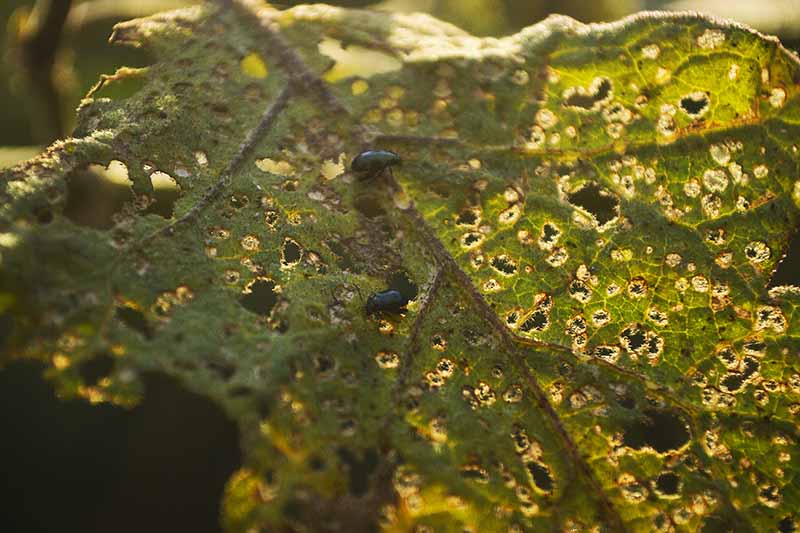
While they don’t easily kill entire plants, they’re a nuisance that can kill leaves and weaken a young eggplant’s health. They’re most common in the southern United States, but can appear anywhere.
To help prevent infestation, avoid planting strawberries and potatoes near your aubergines, as E. fuscula loves both of those crops as well.
If you notice flea beetle damage, spray with Monterey Garden Insect Spray, an organic pesticide available from Arbico Organics, according to package instructions.
And read more about dealing with flea beetles in the garden here.
Eggplant lace bugs (Gargaphia solani) are another common pest. These four-millimeter-long, two-millimeter-wide insects are brown and blocky with lacelike wings.
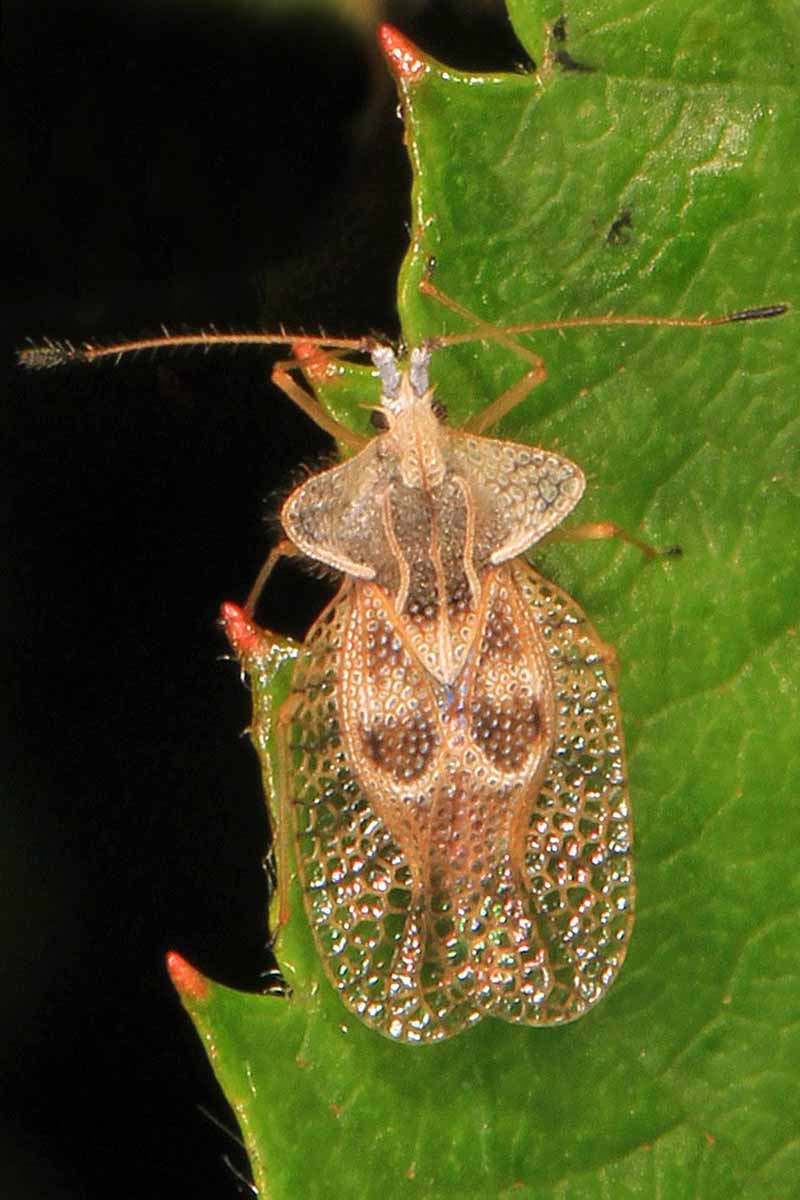
They tend to stay in the southern and southeastern parts of the United States, although they’ve been known to travel as far west as Arizona and as far north as Connecticut.
These insects chew the leaves, causing yellowish discolored spots, and lay eggs on the undersides of the foliage.
An infestation can quickly cause entire leaves to die, which sickens the plant and can even lead to an untimely death.
To help prevent lace bug populations from taking up residence in your containers, keep your eggplants away from other members of the Solanaceae family, as well as sunflowers and sage.
To treat infestations, spray the affected area with Bonide insecticidal soap, available from Arbico Organics.
The two-spotted spider mite (Tetranychus urticae) is another pest to watch out for. But it’s hard to see, at just one-fiftieth of an inch in size! It’s easier to tell these pests are around from the webbing they leave behind.
These mites love dry, dusty conditions and occur all throughout the United States. They feed on the leaves, sucking out sap and causing foliage to turn yellow and die.
To get rid of an existing infestation, remove the webbing as best as you can and spray the leaves with neem oil or insecticidal soap.
You can learn more about spider mites in our guide.
Physiological Conditions and Diseases
Blossom end rot, caused by a lack of calcium in the eggplant fruit, results in water-soaked lesions that get larger over time.
This issue is due to a lack of efficient calcium absorption – a physiological condition rather than a disease caused by a pathogen – but it is a problem that looks terrible.
You can still eat fruits afflicted with blossom end rot, but you’ll have to cut away the rotted portion first.
To avoid blossom end rot, make sure the soil pH is between 5.5 and 7.2 so the plant can effectively absorb crucial nutrients, like calcium.
It’s also important that you avoid disturbing the roots, as this can break them, causing them to have difficulty absorbing nutrients. If you’re going to use a tomato cage, put one in early.
Unlike blossom end rot, the disease known as colletotrichum fruit rot is caused by a fungus – Colletotrichum melongenae. Colletotrichum fruit rot causes sunken pinkish-brown lesions to appear on the fruit.
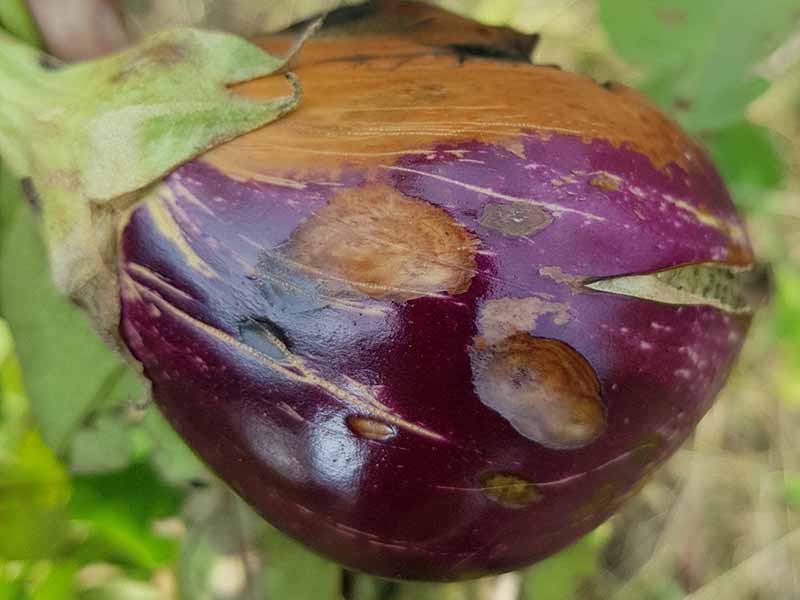
Also called anthracnose, this fungal disease is best prevented by avoiding overly moist conditions that can lead to rot.
Avoid overhead watering, for example, and if there’s an excess of rain and humidity, consider applying a preventative antifungal copper spray to the plant.
This is also the best way to treat an affected plant. Remove the diseased fruits, and if you wish, you can cut the rotted portions off and eat what’s left. Then spray the foliage according to package instructions.
Early blight, caused by the fungus Alternaria solani, causes seedlings to suddenly die. But it can also affect eggplants later on in their development, first showing up as ringed spots on the lower leaves, and then spreading to the rest of the plant.
To avoid early blight in your eggplant crop, don’t keep your containers in an area where you are growing other nightshades, as they can easily spread the fungus to one another.
Treat plants by removing and discarding affected fruits and spraying what’s left with copper fungicide, according to package instructions.
Harvesting
When the fruit is about one-third to half of its mature size as described on the seed packet or plant label and has a glossy sheen, it’s time to pick!
Don’t expect to pick behemoths like the ones you see at the grocery store. Every variety grows to a slightly different size, and eggplants will taste better if you pick them before they reach maturity.
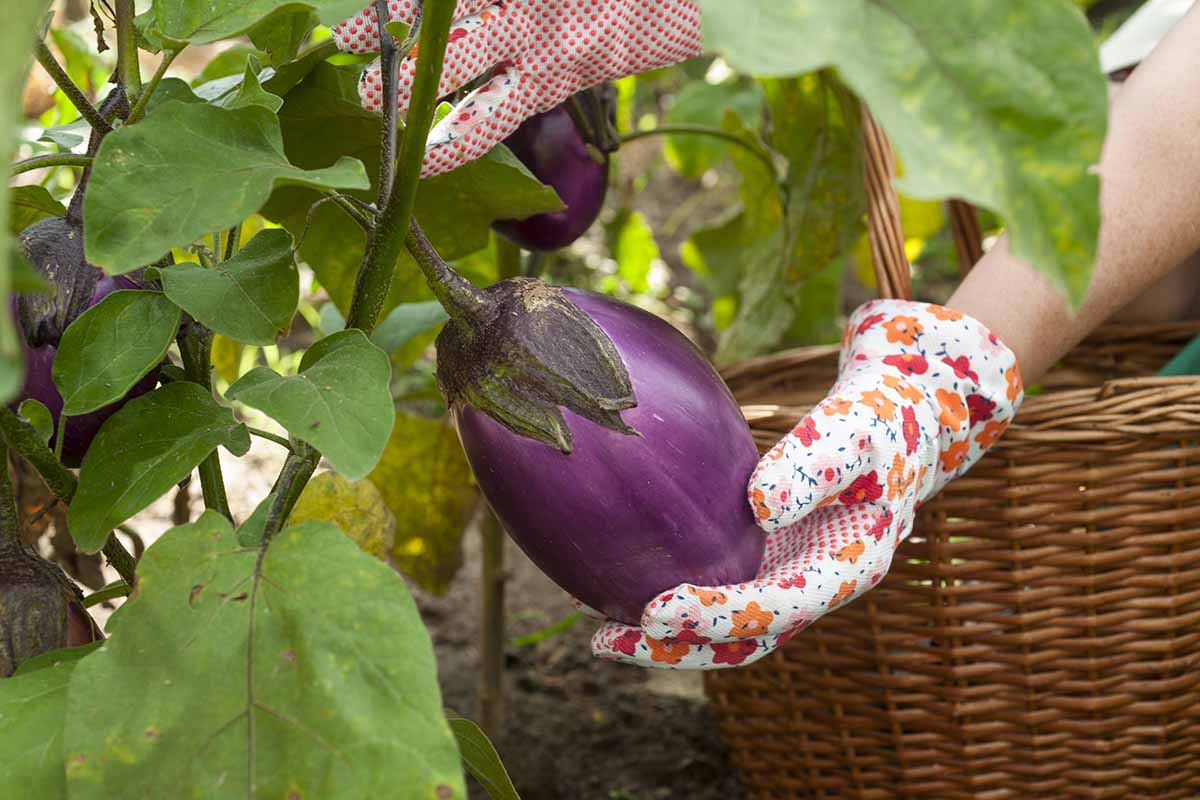
And as a bonus, the plant will put more energy into producing new fruits once you pick a few.
To harvest, put on a pair of gardening gloves first, as eggplants tend to have thorns on and around the stems.
With a sharp pair of scissors, cut the stem about an inch or two away from the fruit.
Recipes and Cooking Ideas
If you happen to be vegetarian and gluten-free, you know that sometimes it may feel like your recipe options are limited.
Not so when it comes to eggplant! This hearty vegetable makes a perfect stand-in for meat in many recipes.
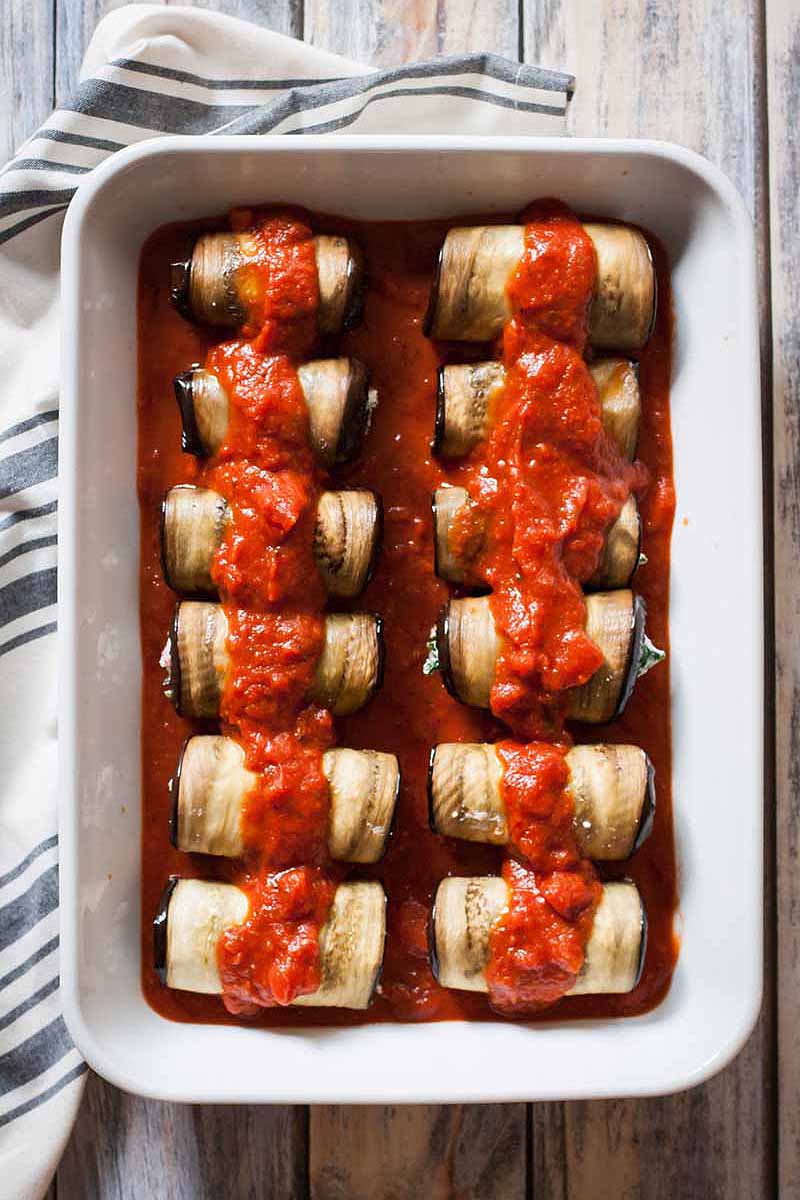
Like this eggplant, kale, and ricotta cannelloni recipe, available from our sister site, Foodal.
Or this recipe for caramelized eggplant and pesto pasta, also from Foodal.
But of course, you can enjoy aubergines even if you love meat. Just try Foodal’s recipe for eggplant stuffed with meat and vegetables to find out for yourself what a delightful combo this can be.
An Egg-cellent Plant
There’s nothing more rewarding than seeing the gleaming purple fruits of your labor waiting to be plucked and plated for your dining pleasure.

Have you ever grown aubergines in containers? We’d love to hear about your experiences! If you have any stories or questions, leave them in the comments section below.
In the meantime, for more information on growing eggplant in your garden, check out these guides next:
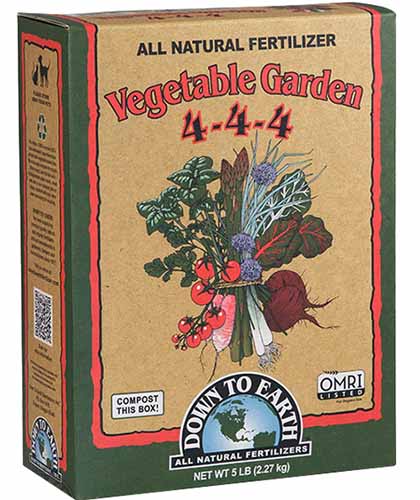


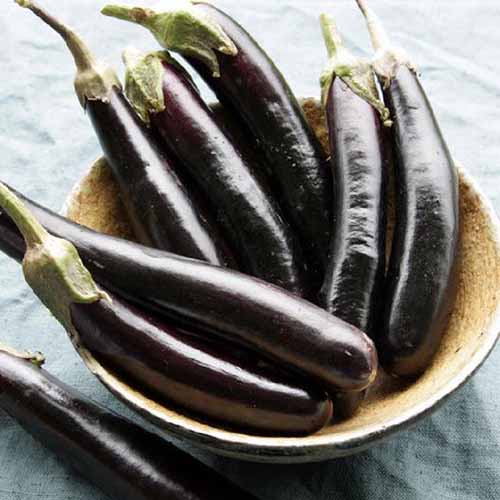
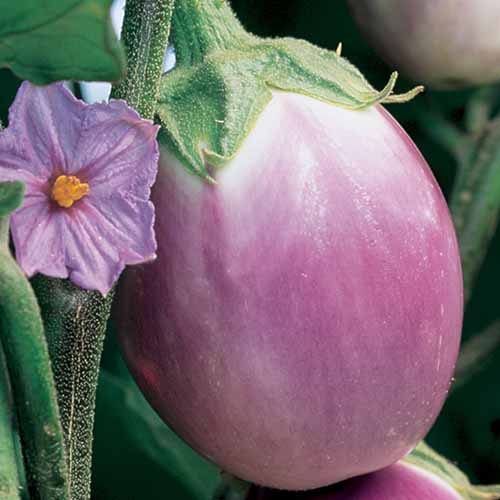
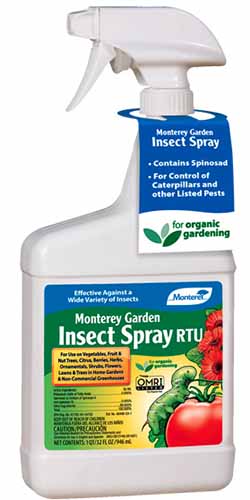
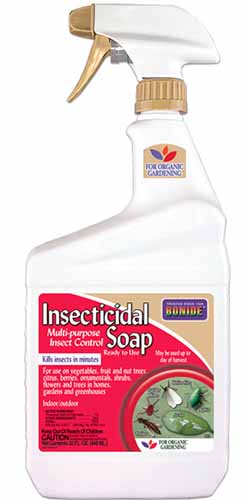
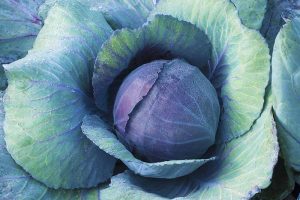
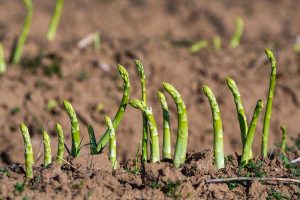
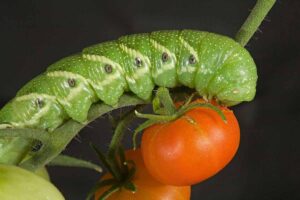
Thank you for your detailed advice on growing brinjals. I harvested them last summer. I grew them in containers in my balcony. They gave me no trouble. I shall grow them again this summer in Montreal, Canada.
I’m glad you enjoyed the article, Annie! Homegrown brinjals are the best, aren’t they?
You. Do go on and on and on. Just wanted to grow in a pot. Stoped reading half way thru
Hope you found the information you were looking for, Guy!